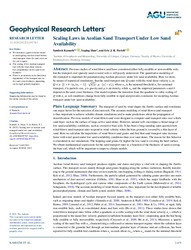Scaling Laws in Aeolian Sand Transport Under Low Sand Availability
DOI: https://doi.org/10.1029/2022GL097767
Persistent URL: http://resolver.sub.uni-goettingen.de/purl?gldocs-11858/10302
Persistent URL: http://resolver.sub.uni-goettingen.de/purl?gldocs-11858/10302
Supplement: https://doi.org/10.6084/m9.figshare.19469501
Kamath, Sandesh; Shao, Yaping; Parteli, Eric J. R., 2022: Scaling Laws in Aeolian Sand Transport Under Low Sand Availability. In: Geophysical Research Letters, Band 49, 11, DOI: 10.1029/2022GL097767.
 |
Dokument öffnen: |
The transport of sand by wind shapes the Earth's surface and constitutes one major factor for the emission of dust aerosols. The accurate modeling of wind‐blown sand transport is thus important to achieve reliable climate simulations and to make predictions about the propagation of desertification. Previous models of wind‐blown sand were designed to compute sand transport rates over a thick sand layer, such as the surface of large, active sand dunes. However, natural soils encompass a broad range of low sand availability conditions, such as crusted or bare soils. It has been a long‐standing open question how wind‐blown sand transport rates respond to wind velocity when the bare ground is covered by a thin layer of sand. Here we calculate the trajectories of wind‐blown sand grains and find that sand transport rates increase faster with wind speed under low sand availability conditions than over sand dunes. The reason for this behavior is elucidated in our simulations: The hopping sand grains fly higher the less sand is covering the hard surface. We obtain mathematical expressions for the sand transport rates as a function of the thickness of sand covering the bare soil, which will be important to improve climate models. Key Points:
We introduce a particle‐based model in investigating Aeolian (wind‐blown) sand transport when the sand cover on the soil is sparse.
The scaling of the Aeolian transport rate with the wind shear velocity has a dependency on the sand cover thickness.
There is an anomaly in the functional dependence of the transport rate on the sand cover thickness, depending on the rigid ground roughness.
Statistik:
ZugriffsstatistikSammlung:
- Geologie [933]
This is an open access article under the terms of the Creative Commons Attribution License, which permits use, distribution and reproduction in any medium, provided the original work is properly cited.

